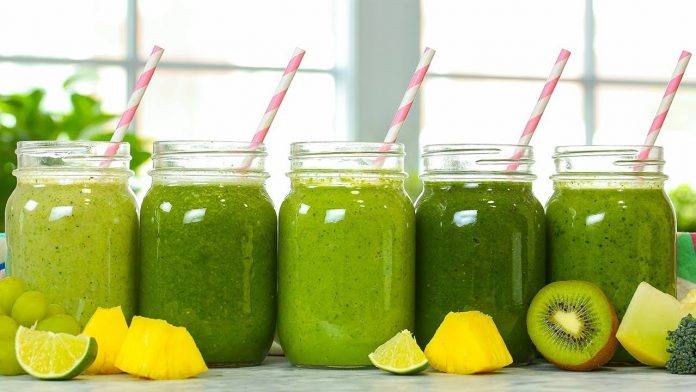Green herbs’ Smoothie has a special place in the healing diet. It is an essential part of the Stablizing Phase Diet. We also highly recommend it during the Preventing Phase Diet.
Green herbs’ Smoothie promotes green’s intake. Most people feel difficulty taking fresh herbs and green leafy vegetables. It is the best solution for them.
Green Smoothie with herbs provides a huge amount of antioxidants and phytonutrients, which help maintain optimum health. Some herbs like basil have neuroprotective, cognition-enhancing and stress-relieving effects. Mint also acts as a neuroprotective. (1, 2)
The green leafy vegetables provide the strongest protection against major chronic diseases. If you take one serving of these greens, they also reduce the risk of heart attacks and strokes.
Recommended Time: 7:30 AM to 9:00 AM.
Recommended Ingredients
| Ingredients | Recommended | Restricted |
| Smoothie Base | Water, Coconut Water, Cucumber, Celery, homemade plant-based milk | Melons, Yogurts (including plant-based yogurts) |
| Leafy Green & Petiole Vegetables | Arugula, Celery leaves, Chicory green, Collard greens, Curry Leaves, Dandelion, Dill Leaves, Drumstick, Endive, Fenugreek Leaves, Kale (black, green, or red), Lettuce (all types), Mustard leaves, Parsley, Radish Greens, Spinach, Sorrel, Swiss chard, Turnip greens, Watercress and Bok Choy (from cruciferous vegetables) | Amaranth, Beet green, Chard (Silver beet), Colocasia |
| Fresh Herbs | Mint (all types) and Basil (all types), Curry leaves, Culantro (Mexican coriander), Dill leaves, Fennel (green), Fenugreek leaves, Giloy, Hyssop, Moringa, Oregano, Parsley, Rosemary, Vietnamese cilantro | – |
| Fruits (fresh) | Any | Melons |
| Dried Fruits (optional) | Currents, Dates, Sultana, Raisin, Apricots, Prunes, figs | – |
| Seeds and Walnuts (optional) | Chia Seeds, Flaxseeds, Hemp seeds, Poppy Seeds, Pumpkin seeds or Walnuts | All other nuts and seeds |
Notes:
- In this type of smoothie, smoothie base, leafy greens & petiole vegetables, and fresh herbs are important than other ingredients. Fruits, dried fruits and seeds and walnuts are optional. You can use fruits for adding sweetness to the smoothies.
- You should not use spinach, sorrel and swiss chard more than once a week. These are high in oxalic acid, which may increase the risk of oxalic acid’s kidney stones. It is also known for blocking calcium absorption in the body.
- Berries (Acai Berries, Barberries, Bilberries, Blackberries, Blueberries, Cranberries, Goji Berries, Loganberries, Mulberries, Raspberries (all types), and Strawberries) are the most recommended fruits. You can also make a smoothie without fruits. Fruits are just added for sweetness.
- Dried fruits (dates, raisins, etc.) are highly recommended for underweight people. Prunes and figs are recommended for people with constipation.
- Seeds and walnuts are highly recommended for children and healthy adults. You can choose any from the listed above in the table, but you should prefer flaxseeds.
How to Make a Green smoothie
| Smoothie Base or Water ** | ½ cup (120 ml) |
| Leafy Green & Petiole Vegetables | 1 cup (chopped) |
| Fresh Herbs – Mint or Basil (any type) | ¼ cup (chopped) |
| Fruits (preferably berries) | 1 cup (sliced) |
| Dried Fruits (e.g., Dates, Raisins, etc.) | 15 g |
| Seeds & Walnuts | 1 tablespoon |
Note: ** If you are using cucumber or celery as a smoothie base, you should take one medium-sized cucumber or two medium stalks of celery. These smoothies are generally thick. We recommend eating with a spoon. If you like normal smoothies, you can increase the amount of smoothie base to 1 cup.
Recommended Method:
- Put all ingredients except fruits (and soaked dates, sultana, or raisins) in a blender.
- Blend to make the smoothie.
- Now, pour the smoothie into a glass.
- Add sliced soft fruits (and soaked dates, sultana, or raisins) as the topping.
- Eat a smoothie with a spoon.
Alternate Method:
Alternatively, you can blend all ingredients along with fruits. But keep smoothie mild coarse to encourage chewing. For this method, we recommend using a low-speed blender instead of high-speed blenders.
How to Take Smoothie
- If you make a smoothie with the recommended method, eat a smoothie with a spoon. Chew it well. Keep each sip in your mouth for a while to mix it well with saliva and anaerobic bacteria.
- If you make a smoothie with the alternate method, your smoothie should be mild coarse to encourage chewing. Keep each sip in your mouth for a while. Do not swallow it immediately. Chew it well. Let it mix with anaerobic bacteria that present in your mouth. These bacteria reside in the grooves, crypts and tongue in your mouth. These bacteria reduce nitrates present in leafy greens and petiole vegetables to nitrites in the mouth. These nitrites are converted into nitric oxide in the stomach when mixed with gastric acid. Nitric oxide is the most important molecules and plays an important role in vasodilation and blood flow regulation. It also acts as a strong cellular antioxidant. It is also important for healing benefits. If you gulp the smoothie down into your gut immediately without chewing and mixing it with anaerobic bacteria, you will not get these benefits. Therefore, keep the smoothie mildly coarse and chew smoothie.
- Rinse your mouth after eating a smoothie to protect the enamel. Why is rinsing important? Because when you blend, some amount of fructose present in fruits gets separated from the fibre. It may hurt your enamel.
If we need to chew, why do you advise smoothies?
We advise because blending helps to break open the cell walls and increases the bioavailability of nutrients in our body to a maximum extent. All plant cells have a cell wall made of cellulose. Our enzymes are not capable of breaking it down. Chewing helps break down cell walls, but it can only break down around 10-30% of the cells, depending on how well you chew. So, cell walls of 70-90% of cells remain closed and are not broken open. Making a smoothie by blending do this job better than chewing. Chewing is also important and essential to mix it with saliva and anaerobic bacteria, as discussed above.
Why do we advise fruits as a topping?
Because fructose gets separated from the fibre when we make fruit juice or blend fruits, it mainly applies to fruit juice. Some amount of fructose also gets separated from fibre during blending. Blended fruits still have a huge amount of fibre, which still force slow absorption. Fructose absorption from fruit juice is very rapid. Its absorption from a coarse smoothie is slow because fibre content is not fully separated in such smoothies. But from whole fruits, its absorption is extremely slow. That is why we recommend fruits as a topping. Suppose you ask me which is best, better, good and worse. I will answer the whole fruit as the topping is the best. Blending coarse smoothie is better. Normal smoothies are also good. Adding fruit juice in smoothies is worse.
Recommended Daily Amount
If you make a smoothie using the above method and taking the recommended ratio of ingredients, you need to decide the quantity according to your age group as given below:
| Age Group | Minimum Recommended Amount |
| 1-2 | 60 ml |
| 2-3 | 80 ml |
| 4-8 | 120 ml |
| 9-11 | 200 ml |
| 12-13 | 250 ml |
| 14-18 | 320 ml |
| 19-50 | 350 ml |
| 51-70 | 320 ml |
| 70+ | 250 ml |
| Pregnant | 350 ml |
| Lactating | 350 ml |
Note: You can drink more as per your tolerance. The minimum recommended amount is the required amount to get healing benefits.


